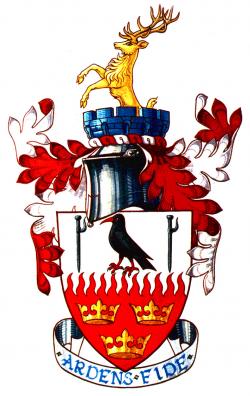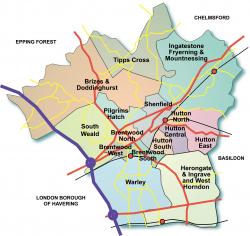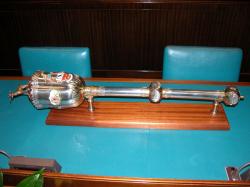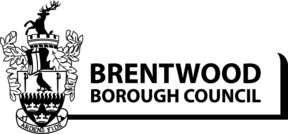Early history
The early history of Brentwood is obscure. A Bronze Age axe has been found in the district and there is an entrenched camp in Weald Park. However, it is unlikely that early man settled on the site of the town because it was probably part of the Great Forest which covered much of Essex.
Although the Great Roman Road from London to Colchester ran through the town, no remains have been found which suggest a Roman settlement.
The Saxons came to South Weald and its bounds included modern Brentwood.
Foundation of the town
Thomas a Becket's murder in 1170, and his canonisation in 1173, played an important part in the foundation of the town. Miracles were wrought at his tomb and pilgrims travelled to the shrine at Canterbury. The most convenient way for those from the Midlands, and for many from East Anglia, ran through Brentwood to the ferry at Tilbury. Houses sprang up in a clearing in the forest, made either by an accidental or deliberate fire, and seven years after Becket's death, the name of Brentwood (Burnt Wood) appeared for the first time in history.
In the latter half of the 12th century, William of Ockendon gave to the Abbey of St Osyth his lands of Brentwood called Cocstede. Permission was granted by the Vicar of South Weald for the Abbot of St Osyth to build a chapel for use of the growing population and passing pilgrims. It was dedicated to St Thomas of Canterbury. Only the ruins remain today in Brentwood's High Street (pictured above).
The town was beginning to grow in importance. It was the centre of an agricultural district, the crossing place of two important roads and a halt on the pilgrims' route; it was a natural centre for business. Henry III granted a Charter for a market in 1227. The growth of the wool trade and cloth industry in Essex encouraged the development of the town. To the pilgrims passing through were added merchants, many of them Italians.
Medieval remains found in Hart Street
Archaeological investigation of a site in Hart Street, in the town centre, back in 2000 provided proof of medieval inhabitant as well as some activity from as early as the 12th century.
Some of the original foundations of the town were revealed, including a medieval bread oven, a number of wells and a cess pit, a 16th century iron foundry, plus the walls and drainage of at least three or four medieval homes, some of which still displayed the scorched clay of their fires. Various items found included pottery, nails and coins.
State of discontent
In 1381, southern and eastern England were in a state of discontent. There were many reasons: the failure of the French Wars; the Labour Laws following the Black Death; the desire of villains to be free of labour services and feudal dues.
However, the spark was fanned to a flame by a poll tax levied on every lay person, male and female, over the age of 15. The procedure of the tax was disappointing, and the Commissioners were ordered to enquire how each township had been taxed. A court was held in Brentwood on 30 May 1381 and, following a riot, the Commissioner, Thomas Bampton, was driven from the town.
Sir Robert Belknappe, the Chief Justice of the Common Pleas, was sent to restore order and punish the 'evildoers', but he was seized by a mob and forced to leave the town. Before departing, he was forced to give the names of the jurors who had 'presented' the names of the original rioters. Those the mob could catch they beheaded, together with tree clerks of the Commissioner. The rebels then joined the Peasants' Revolt, led by John Bull and Wat Tyler in London. After the death of Tyler, the rebels were defeated at Billericay.
After these events, Brentwood sank back into itself. For the next 150 years it was a small market town under strong ecclesiastical influence, for the Church was the chief landowner.
Religious struggles
The Reformation and the Dissolution of the Monasteries brought about great changes and, after passing through various hands, the twin manors of South Weald, Costed and Caldecots, became the property of Antony Browne. He founded Brentwood School and almshouses at South Weald.
The religious struggles of the time left their mark. In 1555, William Hunter was burned 'at the town's end where the butt stock' for his religious beliefs. He had argued with Thomas Wood, the Vicar of South Weald, as to the nature of the communion.
Spanish threat
The year 1588 saw the country in great peril from the Spanish Armada, and soldiers were dispatched to Brentwood in readiness. Again in 1597 when Philip II, spurred by the sack of Cadiz by the Earl of Essex, threatened invasion, there was a muster of militia at Brentwood; 4,000 on foot and 400 on horseback were ordered to rendezvous at Ingatestone and Brentwood, but the Spanish threat came to nought. After 1600 the population was probably between six and seven hundred, living in some 90 houses, most of which were in the High Street and Back Street (now known as Hart Street).
Civil war
The political and religious upheaval of the first half of the 17th century did not leave the town unmoved. Sir John Lucas of Shenfield, Sir Denner Strutt of Little Warley, Sir John Tyrell of East Horndon and Anthony Browne of South Weald all fought in support of the King, while Mr Luther of Kelvedon Hatch was prominent among the Parliamentarians.
However, the tide of war passed by until 1648, when the second Civil War broke out. The Royalists in Kent were defeated, marched into Essex via Bow Bridge and, after an overnight stop at Romford, marched through Brentwood on 8 June, where they were joined by a party on horse and foot under Sir Charles Lucas of Colchester. Close on their heels were the Parliamentarian forces of Colonel Whalley and Sir Thomas Fairfax, who eventually besieged the Royalists at Colchester and forced their surrender.
The troubled time came to an end in 1660 with the restoration of Charles II, when the bells were rung to celebrate at both South Weald and Brentwood. Samuel Pepys visited this town on a number of occasions, and celebrated the Coronation in Brentwood, where he awoke the following day the worse for drink.
Mock battle
The American War of Independence broke out in 1775; in 1778 France joined in the struggle and Great Britain was in danger of invasion. Seven thousand militia were camped on Warley Common which had increased to three regular and eight militia battalions by June. In October, George III and Queen Charlotte visited Lord Petre at Thorndon Hall to inspect the troops. The review included a mock battle in which 10,000 men were engaged. The following month the camp broke up, but was reformed in 1779, 1781 and 1782.
The French Revolution and Napoleonic wars saw the re-establishment in 1793 of the camp at Warley, and in about 1805 the barracks at Little Warley were built.
In 1793 the town was described as a populous place, with good inns, chiefly maintained by the multitude of passengers and carriers passing through to London. The White Hart (now known as Sugar Hut), so named after Richard II, who was said to have stayed there in the 15th century, is positioned in the middle of the High Street. It is one of the finest medieval inns in England and there is evidence to suggest that much activity took place on the site from around the 13th century, pre-dating the present structure.
The 16th century carriage entrance leads from the High Street to the inner courtyard which still exhibits a complete example of a wooden arched gallery. The fine workmanship of the inn is still apparent and suggests that it could have been built as a pilgrims' hostel, possibly sponsored by the monks of St Osyth.
Comparisons between the gallery of the White Hart and others in England show it to be the most complete and the most elegantly constructed of those that survive.
Before the advent of the railway, Brentwood's communications with the outside world depended mainly on the London-Colchester Road. Inns and hostels became regular stopping places for coaches. In 1791 there were three daily Brentwood to London coach services, and a wagon service four times a week.
Improvements to the main roads at the end of the 18th and the beginning of the 19th centuries brought about a considerable increase in traffic through Brentwood. The great Mr Macadam himself worked on the Shenfield to Chelmsford Road in 1833. To accommodate its growing trade, the White Hart's street front was extended eastwards during the 19th century, with a new north-east wing behind it, allowing 50 coach horses and 15 post horses to be stabled.
To modern times
The outline of the modern town was beginning to appear. The population grew steadily after 1800; there were 1,007 inhabitants in 1801, 1,642 in 1831 and 2,364 in 1841. The decisive year in the history of the town was 1843, when the Eastern Counties Railway opened. As a result, the town which had confined itself to the crest of the hill, along which the High Street ran, began to spread down to the station in the valley.
A Parish Council was formed in 1888, which assumed most of the duties of the former church vestry, but it was not until 1899, following establishment of an Urban District Council, that modern Brentwood began to appear. The Urban District was considerably enlarged as a result of the Essex Review Order in 1934, and finally with the passage of the Local Government Act in 1972, the new District of Brentwood came into being with an area of nearly 40,000 acres (16,194 hectares) and a population approaching 75,000.
On 27 April 1993, Brentwood's first Mayor was inaugurated and celebrations took place throughout the Borough in recognition of its attainment of Borough status. The Borough of Brentwood entered a new phase in its historical development.
Further reading on this subject: Fireside Talks about Brentwood by John Larkin is available from local bookshops.
Armorial bearings
 The Achievement of arms was granted to the former Brentwood Urban District Council. The Armorial Bearings, which were designed by Lawrence King, OBE, FRIBA, and approved by the College of Heralds, have since been transferred to Brentwood Borough Council.
The Achievement of arms was granted to the former Brentwood Urban District Council. The Armorial Bearings, which were designed by Lawrence King, OBE, FRIBA, and approved by the College of Heralds, have since been transferred to Brentwood Borough Council.
The Achievement illustrates, as far as possible, the important facts in the history of Brentwood.
The shield is divided horizontally by a flame-like division known heraldically as 'rayonee'. The lower half of the shield is red, while the upper half is silver. This division gives the appearance of flames for Brentwood's old name of 'Burnt Wood'.
The three crowns of the Abbey of St Osyth have been incorporated in the shield. The lands of Brentwood were held by the Abbey from Henry II's reign to the time of the Dissolution of the Monasteries.
In the upper part of the shield there is a Cornish chough, a black bird with red feet. This is one of the symbols of St Thomas of Canterbury, the Patron Saint of the town, and to whom the old pilgrims' chapel in the High Street is dedicated by the name of local area Pilgrims Hatch, and the palmer's, or pilgrim's, staff has been placed on either side of the chough.
The crest above the helmet includes the battlements of an heraldic tower, intended as a rebus since the name of the late owner of the ancient manor house, Weald Hall, was Tower.
Arising from the battlement is a stag's head, reminding one of the deer which used to be seen in Weald and Thorndon Country Parks, and have now been reintroduced to Weald Country Park.
The description or blazoning of this Achievement of Arms is described in heraldic language as follows:
"Per fesse rayone, argent and gules. In chief, a Cornish chough proper between two pilgrims' staves erect sable, and in base three ancient crowns two and one or. Crest: on a wreath of the colours issuant from the battlements of a tower azure a demi stag or."
The motto: 'Ardens', meaning 'burning', is a descriptive of the name 'Burnt Wood'. 'Fide' represents our faith in God, our fellow men and our future.
Borough status
 The creation of a Borough is an ancient and honourable status granted to established communities. Brentwood's long history and tradition, coupled with its strong sense of community and civic identity, won it Borough status in March 1993.
The creation of a Borough is an ancient and honourable status granted to established communities. Brentwood's long history and tradition, coupled with its strong sense of community and civic identity, won it Borough status in March 1993.
The status is conferred by the reigning monarch.
Brentwood's Charter reads:
'Elizabeth the Second by the Grace of God of the United Kingdom of Great Britain and Northern Ireland and of Our other Realms and Territories Queen, Head of the Commonwealth, Defender of the Faith: To All To Whom These Presents Shall Come. Greeting!
Whereas certain new local government areas known as districts were established by the Local Government Act 1972;
And whereas a petition praying for the grant of a Charter conferring upon the District of Brentwood the status of a borough has been presented to Us by the council of the said District:
And whereas We are pleased by the advice of Our Privy Council to grant a Charter for such purpose:
Now Therefore Know Ye that We by virtue of Our Prerogative Royal and in pursuance of the Local Government Act 1972 and of all other powers enabling Us in that behalf, have granted and declared by these Presents do grant and declare that the District of Brentwood shall have the status of a Borough.'
The Charter is signed personally by Her Majesty the Queen.
Following Borough status, the Council inaugurated the first Mayor.
The mace
 Traditionally, the Mayor of a Borough is accompanied on certain civic occasions by the mace and bearer. Nowadays, of course, the mace is purely a ceremonial staff of office but back in the Middle Ages it was a weapon, a type of club usually with a spiked metal head.
Traditionally, the Mayor of a Borough is accompanied on certain civic occasions by the mace and bearer. Nowadays, of course, the mace is purely a ceremonial staff of office but back in the Middle Ages it was a weapon, a type of club usually with a spiked metal head.
Brentwood's mace, made for the new Borough, is a thing of beauty, a unique item of Brentwood's heritage and a tribute to the craft of Ron Chapman, one time councillor and long established jeweller in the High Street.
The mace measures around three feet in length and is made entirely from silver. The head is scalloped and has five sides depicting, in coloured enamel, the coat of arms or crest and scenes around the Borough. The top edge of the head is shaped to represent battlements. Gilded flames cradle the base of the head and feature around the staff which is hollow silver.
The original 'Burnt Wood' of Brentwood's name is incorporated into the design and where the staff meets the head the silver has been cast in wood.
The five sided bosses in the middle and at the end of the staff include engraved depictions of the parishes and villages of Brentwood. The head is topped with scroll work and a deer, and the base finished with an acorn.
